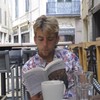This piece originally appeared on VICE Belgium.It is grey and cold in Loon-Plage, a small town in Westhoek, a region that straddles France and Belgium. The landscape is dotted with shopping malls and chain stores. Look closer, though, and you’ll notice toothbrushes, tents and SIM cards littering the roadsides. Thin plumes of smoke drift through the air, alerting passersby to the presence of nearby people.
Advertisement
Loon-Plage isn’t just home to the likes of Lidl. Hundreds of migrants are still living in limbo between Dunkirk and Calais, and many of them have made camp here. Their circumstances are awful; tents and sleeping bags are routinely confiscated and destroyed by the police. Basic human needs – food, water and a safe place to sleep – are not being met.We end up under a bridge that leads to one of the camps via an improvised staircase that has been moulded into the dirt. A man sits at a table selling cookies and tobacco, swaddled in a white winter coat. The past few days have brought heavy rainfall, and the entire area resembles a mud pit.
“Look, that’s where I sleep,” says Ouman, 24. He was born in Ethiopia, has a Guinean passport, and has lived and worked in France for the past five years. His parents and sister have resided in the UK for years now, but despite several attempts to join them, Ouman has never been able to legally cross the Channel.Next to him sits Kadjan, 33, from Sri Lanka, who has also lived in France for years. He has been arrested several times during his time in the country. “It’s clear that I am not welcome here,” he says. “I’m sick of being bullied by the police, I want to go to England.”
Advertisement
Ouman and Kadjan met here at the camp, became friends and made their first crossing attempt together. The motor of their boat gave out just three hours into the journey. “We were drifting around for hours out at sea, until the French police stepped in and brought us back to Calais once again,” Kadjan says.
Ouman and Kadjan.
Dover is just 34 kilometres away from Calais – it is also one of the most dangerous and busiest sea routes in the world. Despite this, the majority of the 2,000 people living in these camps plan on making the crossing at some point. Like Ouman and Kadjan, many of them have already tried and failed to reach the white cliffs of Dover.“There are people who already know for sure, at the start of this trip of a lifetime, that they want to end up in the UK. Because they have family there or because they speak the language, for instance,” says William Feuillard, a 23-year-old coordinator at L’auberge des Migrants, an NGO that carries out social work in Calais. “But there’s an equally sizeable group that wants to go to England to escape the hopelessness in France and other places.”
William Feuillard, coordinator at L’auberge des Migrants, a charity which seeks to provide migrants with daily goods.
The situation is caused in part by the 2003 Dublin Regulation, a law that was passed in an attempt to ensure that people who had their asylum claims denied would not attempt to lodge another claim in a different European Union member state. The rules state that people have to apply for asylum in the first EU country they enter, so if you arrive in Greece, have your application denied, and then try to get into, say, the Netherlands, you will be sent back to your point of entry.
Advertisement
This is what makes the UK even more appealing to asylum seekers than it has been in the past. On the 31st of January 2021, the UK officially left the EU, nearly five years after an era-defining referendum. One outcome of the Brexit vote is that the Dublin Regulation no longer applies to the UK – prior to that the UK could easily send migrants back to their original point of entry. Things are a lot murkier now.Everyone we spoke to in both Dunkirk and Calais wants to request asylum in the UK. Though neither the French nor British governments like to admit it, 98 percent of these people do exactly that as soon as they get there. However, the majority of these requests are rejected by the British authorities. In some years, up to 88 percent of applications for asylum failed. Over the past 15 years or so, three-quarters of applications have met this fate, and only a third of those rulings were overturned after the asylum seeker made a formal appeal.To make an asylum request, you must physically be on British soil. “Because the safe travel options – planes, cars, trains, ferries – have been made impossible, crossing the Channel directly is the only remaining option,” says Feuillard.
Advertisement
As for the settlements in Calais: “We’ve seen an unbelievable decline in the quality of living circumstances in these camps in recent years,” he says. Feuillard partially attributes this to what he describes as “increasing militarisation at the border.” The coastline, in fact, is now patrolled by drones deployed by Frontex, the EU’s own border guard agency.The increased security levels are apparent as soon as you enter the Calais harbour area. Vans belonging to Campagne Républicaine de Sécurité, a sect of the French police force traditionally associated with riot control, keep watch at a roundabout. “Every possible security force is present here in Calais,” says Feuillard. “This is the place where the ratio of police officers to citizens is at its highest. Riot police, the gendarmerie - you name it, they’re here. That’s because they want to send a clear and strong signal: Migrants aren’t welcome here. It isn’t just hostile – it is demeaning, too.”Since the death of 27 migrants in the Channel in November 2021 – the worst disaster of its kind on record – France and the UK have blamed one another for the tragedy. One survivor, Mohammed Sheka, told Kurdish public broadcaster Rudaw that the people on the boat called the British police during the fatal crossing. They were told to call the French authorities. The French, in turn, told them to contact the British. An inquiry into the incident is ongoing.
Advertisement
Guillaume, a 38-year-old who declined to provide his surname, has worked at a funeral home in Calais for a decade. We met him at the space where WoodYard, an organisation which provides migrants in the camps with wood, is based. Their deliveries of timber are used for warmth, cooking, and drying wet clothes.He’s been helping out since the November tragedy. “I come here every day,” he says. “Just for 30 minutes or so on my break. Standing idly by is no longer an option.” He tells us that he received a phone call from the police on the 24th of November. “They wanted to know how fast I could get to Dunkirk and how many hearses I could bring. A boat full of migrants had just capsized.”When he got to the beach, he couldn’t believe his eyes. The bodies of the victims were lined up on the shore. “Men, women, kids. There were so many of them,” he recalls. He helped the police officers put the bodies into black bags. “The looks on their lifeless faces are etched into my memory,” Guillaume says. He shows me a picture on his phone. It is a photo of a woman who died with her younger brother, her mum and her dad.
The space WoodYard uses is shared with several other organisations looking to improve the quality of life in the camps. There are piles of firewood, clothes, canned food, tents. It is a picture of privately donated, organised chaos. We spoke to Ruby, 24, who was busy refilling a massive water tank in a cargo fan. “This one holds 1,000 litres,” she says, before adding: “We have to be careful. The police don’t like it when we help the migrants.”
Advertisement
It is a belief shared among numerous governments that NGOs who help migrants are just exacerbating the problem. Because of this, NGOs find themselves being sabotaged. In the first camp we visited a wall that was built to stop donation drop-offs happening. The entrance in another camp we saw had also been blocked. “At first they put down small rocks we could easily remove,” says Ruby. “Then they became bigger and bigger and by now they’ve been secured in place with cement.”Along the way, we met two other volunteers from an NGO. One, who calls himself Toucan, uses a wheelbarrow to distribute bushels of firewood around the camps. He shows us the remnants of tear gas grenades which had been thrown the day before when a violent clash between police and migrants broke out. The latter had their tents confiscated; they were not given any time to gather up their strewn belongings.
Broadly speaking, the approach taken by the police in this part of France centres on exhaust and neglect. The same camps are cleared over and over again. Every 48 hours, the police intervene somewhere random by destroying or removing personal property. “Those interventions take place across the camps. It is unabashed bullying,” says Feuillard. “We’ve nearly run out of tents. The situation is so demoralising for migrants. They lose everything time and time again.”He tells us that larger evacuations take place on a monthly basis. “Buses show up at the camps unannounced. People are taken and dropped off all over France. The camps are cleared out completely and locked up to make sure no new camp is built in these locations in the future. But these efforts are in vain, because most [people] just come back.”In 2021, France drove away 172,469 people from these camps - 472 people a day. Ninety percent of those people were staying in Calais or Grande-Synthe.
In the 90s, at the advent of the Calais saga, refugees tended to be Bosnians fleeing from the civil war that led to the dissolution of Yugoslavia. Later they were joined by migrants from Iraq, Kurdistan, Pakistan, Afghanistan, Eritrea, Syria and Somalia – the numerous victims of numerous crises and wars that followed each other in rapid succession. “As long as Europe doesn’t change its immigration policies, these migration waves will keep happening,” William concludes.In Loon-Plage, Kadjan takes us to his tent. While he makes a fire, Ouman puts an arm around his shoulders. “Don’t worry, man. Things will get better as soon as we get to England.” They’ll be trying their luck again later this week.

